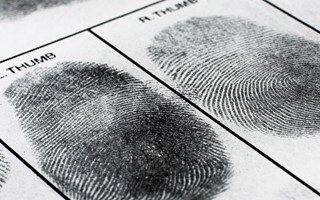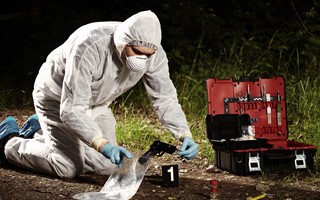News January 23, 2024
For many years now forensic science has formed an essential part of any case moving through the court system which involves the interaction of humans with each other or with the environment around them.
DNA profiling can prove immensely powerful in addressing questions about who biological material has originated from. However, it is the success of this technique that has pushed the central focus for many cases away from questions about the source of a particular piece of evidence, to a more nuanced evaluation of the actions of individuals during and after an alleged crime.
In any incident where someone sustains a bleeding injury, blood can be distributed to individuals involved and to the environment around them. This is where Blood Pattern Analysis (BPA) can be employed to address questions central to the court’s understanding of events.
Pattern Recognition
BPA involves the identification of patterns of staining. Pattern recognition skills are, by their nature, subjective – but these skills rest on sound scientific principles and are bound by objective criteria which guides a forensic scientist in their decision making.
By identifying and understanding the patterns at a scene, on clothing or a proposed weapon, a forensic scientist can comment on the activities which may have been undertaken. Patterns containing characteristic identifying details can be formed by:
- Contact between a bloodstained and non-bloodstained surface
- Blood dripping from a wound onto another surface
- Blood dripping into a pool of blood
- Impacts into wet blood
- Blood cast off a moving object
- Blood expelled from the airways
- Blood shed from an arterial injury
The amount and distribution of blood transferred will depend upon such factors as the nature and duration of any contact, the proximity of the people/objects involved, the nature of the injuries sustained and the amount of blood that was shed.
It is also the case that specific types of action, such as kicking, punching or the use of a firearm can, on occasion, give highly characteristic distributions of blood containing fine detail. This can add strength to a forensic scientist’s interpretations.
Some of the patterns generated by the examples listed above share some identifying features and often a complex mixture of patterns is encountered. However, with the use of objective criteria and careful consideration of the contextual and medical information in the case a sufficiently experienced scientist can form a reasoned judgement on questions regarding what activities may have occurred.
BPA in Criminal Investigations
BPA can be a powerful reconstruction tool - assisting in building a picture of what may have happened during and after blood was shed. It may also be of use in answering questions such as:
- What was the position of the victim and offender and/or objects at the time of bloodshed?
- How have individuals/objects moved/been moved through the scene?
- Was there a fight or struggle?
- What type of weapon were used?
- How many blows, shots or actions occurred?
- Was the offender injured? Which blood is theirs within the scene?
- What bloodstaining might we expect on the assailant?
- Has there been an attempt to clean up after the assault?
The above questions are investigative in nature and can be particularly useful when there is little information available.
With cases at trial there will often be defined prosecution and defence positions. In these circumstances BPA is particularly powerful. The scientist can use their detailed understanding of the bloodstain patterns in the case, and a knowledge of the mechanisms which could generate them. They can then apply this understanding to the differing versions of events put forward, making a judgement about whether the bloodstain evidence is more likely given one version of events rather than another.
Limitations of BPA
Understanding what BPA cannot say is as important as understanding what it can say. The following are some areas where caution is needed:
Bloodstains cannot be aged purely from their appearance. This should be considered when assessing bloodstaining at a scene or on clothing where there might be historical incidences of assault/bloodshed.
Where multiple individuals have bled. Care must be taken not to assume that certain blood patterns are from a particular individual without good cause. DNA profiling should be used to minimise uncertainty.
Some observed patterns could relate to the actions of attending paramedics, witnesses, police officers, crime scene investigators and forensic scientists. Statements/video footage from those attending can be vital in fully evaluating the findings.
Assaults are often dynamic events consisting of a multitude of movements and actions of which the individuals involved may have little awareness/recollection. In considering accounts given by prosecution and defence, it is essential to appreciate that these are highly unlikely to detail every movement made.
The Defence Review
Forensic Access’ scientists regularly conduct BPA on items previously examined by the prosecution, items not previously examined, and scenes and vehicles. We can also review blood patterns from photographs.
Through our many years of casework experience, we understand the usefulness of BPA but also the dangers of over interpretation and misinterpretation of blood patterns.
A defence review of any BPA case will look at all the factors which are critical to the evidence being robust, balanced and correctly informed.
Case examples:
- Though not alleged, a defendant’s charge was increased to include kicking based on the BPA conducted by the prosecution scientist. Our defence review showed that the patterns had been misidentified and instead of kicking could be more readily explained by the more passive action of blood dripping into blood already on the ground. This was put to the Crown scientist and agreed resulting in the kicking charge being removed.
- Prosecution evidence was that blood patterns in a vehicle were deposited from an assault taking place wholly outside the vehicle. This did not align with the defence case statement. A re-examination of the vehicle and reconstruction of blood trajectories showed that the Crown’s evidence was incorrect, and part of the assault must have taken place inside the vehicle.
- The Crown scientist reported that the BPA supported the view that a defendant had assaulted the complainant as alleged. Our review gathered scene photographs and body worn video from first responders, not seen by the Crown scientist, and together with a review of the clothing showed that the bloodstain evidence was in fact neutral, leading to the Crown scientist re-issuing their report to reflect this.
Contact Forensic Access
Do you have a case involving BPA or requiring a scientist to review BPA evidence? Don't miss out on the evidential opportunities BPA can provide for your case. Work with our casework management team to effectively delegate, save time and strengthen your defence strategy. Contact us at science@forensic-access.co.uk or (+44) 1235 774870.


